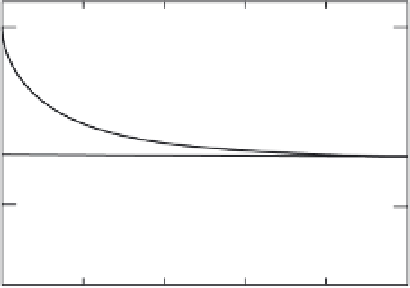Geoscience Reference
In-Depth Information
example,
Crystallization percent
100
90
80
70
60
50
x
(Rb
/
Sr)
1
+
(1
−
x
)(Rb
/
Sr)
2
(Sr
2
/
Sr
1
)
x
(Rb
/
Sr)
mix
=
+
−
x
)(Sr
2
/
D
Sr
/
D
Rb
(1
Sr
1
)
Modern enriching
fluids
(
87
Sr
/
86
Sr)
mix
Ancient enriching
fluids
x
(
87
Sr
/
86
Sr)
1
+
(1
−
x
)(
87
Sr
/
86
Sr)
2
(Sr
2
/
Sr
1
)
=
(Rb/Sr)
N
Sr
1
)
These are hyperbolas, and the shape or curva-
ture of the hyperbola depends on the enrichment
factor
E
. Depleted magmas when mixed with an
enriched magma can appear to be still depleted
for some elemental and isotopic ratios, unde-
pleted or 'primitive' for others, and enriched for
others, depending on
E
. This simple observation
can explain a variety of geochemical paradoxes.
For example, many basalts are clearly enriched,
relative to primitive mantle, in some isotope and
trace element ratios but enriched in others. Note
that trace element and isotope ratios cannot sim-
ply be averaged; mixtures are weighted averages.
Likewise, the means and variances of ratios have
little meaning without information about the
concentrations.
Trace-element and isotope data for magmas
sometimes appear to be inconsistent. The incom-
patible elements and strontium and neodymium
isotopes show that some abyssal tholeiites
(MORB) are from a reservoir that has current
and time-integrated depletions of the elements
that are fractionated into a melt. MORBs, how-
ever, have Pb-isotopic ratios suggesting long-term
enrichment in U/Pb. Alkalic basalts and tholei-
ites from continents and oceanic islands are
derived from LIL- and U/Pb-enriched reservoirs.
Strontium- and neodymium-isotope ratios, how-
ever, appear to indicate that some of these
basalts are derived from unfractionated reser-
voirs and others from reservoirs with time-
integrated depletions. These inconsistencies can
be reconciled by treating oceanic and continen-
tal basalts as mixtures of magmas from depleted
and enriched reservoirs, or components, and as
blends of small-degree and large-degree melts.
MORBs can be thought of as slightly contami-
nated, depleted magmas, or as large-degree melts
of a heterogenous source plus some small-degree
melts. Oceanic-island and continental basalts
are different, less homogenous, mixtures. The
x
+
(1
−
x
)(Sr
2
/
Melt
1
Residual cumulate
D
Rb
/
D
Sr
Modern depleted
reservoir
Crystals Ancient
depleted reservoir
0
0.1
0.2 0.3
Melt fraction
0.4
0.5
Fig. 25.6
Composition of the melt phase and the residual
crystals as a function of melt fraction for a crystallizing
eclogite cumulate. A hypothetical residual cumulate is also
shown. The residual cumulate is formed by extracting half of
the melt fraction. This shows that the composition of the
depleted reservoir is nearly constant with time. Therefore,
progressive depletion is less important an effect than
progressive enrichment.
D
Sr
and
D
Rb
are partition
coefficients.
that can explain the geophysical and geochem-
ical observations. The transfer of KREEP-like or
kimberlitic material can explain the depletion
and enrichment of various lithologies. Similar
scenarios have been developed for the Moon.
The role of magma mixing
Melting regions in the mantle involve large
degree melts toward the center and low-degree
melting on the wings and at greater depth. Melts
pond beneath the crust or lithosphere, collect in
magma chambers, and mix or blend or hybridize.
When two magmas are mixed, the composi-
tion of the mix, or hybrid, is
x
C
i
+
(1
−
x
)
C
i
=
C
mix
i
where
x
is the weight fraction of magma
i
,and
C
i
,
C
i
and
C
mi
i
are, respectively, the concentra-
tion of the
i
thelementinmagma1,magma2
and the mix. Mixing relations for elements are
therefore linear.
The mixing relations for ratios of elements
or
isotopic
ratios
are
more
complicated.
For















